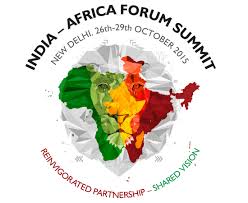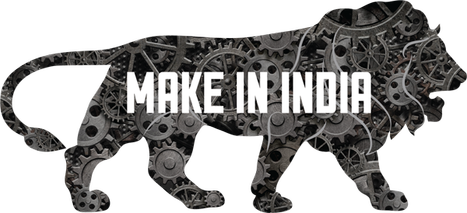Up until now, 1983 was when India hosted the largest congregation of heads of state, all in New Delhi at the same time. Indira Gandhi was the Prime Minister, and her guest list included Fidel Castro, Zia Ul-Haq and Hosni Mubarak.
This month, the Modi government is angling to top that bash, by inviting heads of all 54 African states. This is for the third edition of the India-Africa Summit Forum (IAFS III), which is being held at New Delhi from 26 October to 29 October.

The logo of India-Africa Summit Forum. Pic: iafs.in
The largeness of the event is in style with several initiatives by the current government. While the Summits under the UPA saw representation only from countries defined by the African Union according to the Banjul formula, the BJP-lead NDA government has sent out a continent-wide invitation to reflect “India & Africa's desire to engage more intensively for a better future,” the Prime Minister tweeted.
"Before this government, there was a lack of enthusiasm in foreign policy and business. This government seems to want a multi-vectoral policy, looking for new markets and asserting India’s role as a major global player,” says Ambassador BS Prakash, former Ambassador to Uganda, Rwanda and Burundi.
Under IAFS, India provides capacity building and technology sharing. It aims to enhance cooperation in politics, economics and science. India has a spectrum of concerns, ranging from giving training in drug law enforcement to providing $ 1 million to a basket weaving project. India provides $ 7 billion in lines of credit, and is popular for providing 22000 scholarships for African students.
The Pan African e-Network Project, the brainchild of the late President Abdul Kalam, is active in 48 countries, providing e-medicine and e-education. In 2008, agriculture was a key priority. In 2011, more concrete promises were made by India in terms of cash and kind, such as to set up institutes for trade, education, IT, diamonds, food and textiles.
Make In India and IAFS
The IAFS logo is a lion, which as the website says is symbolic of being "Proud, Courageous, Bold and on the Prowl". The 'Make In India' logo is also a lion, and one thing to watch out for is how African and Indian interests will interact on this front.

The logo of Make in India, an initiative of the present Indian government. Pic: Wikimedia Commons
Resource rich Africa is largely a primary commodity exporter and India imports various items including crude petroleum, gold and coal briquettes from there.
“Africa is also saying, ‘Make in Africa.’ Africa wants India to set up business, not just to use raw materials and sell back finished goods,” explains Nivedita Ray, research fellow at Indian Council of World Affairs. The continent needs and wants to further its manufacturing sector.
At a 2013 India-Africa trade meet, the South African Minister for Trade and Industry commented on the need to usher in an “age of industrialization in Africa with a greater thrust on value addition, moving away from commodity led export models.” Mauritius, Kenya and South Africa are leading in this regard, according to a 2014 KPMG report.
India and Africa are not direct competitors in the manufacturing sector, but African leaders need to consider how India’s push with 'Make In India', will affect their plans for either India or other investors to set up shop on the continent.
At IAFS II, India committed to enhancing value addition and processing of raw materials in Africa. India's Duty Free Tariff Preference Scheme aims to increase African exports to India. But at the same time, 'Make In India' is pushing for investment in various sectors within India, some of which are dear to African interests, such as the leather industry in Ethiopia or food processing in Kenya. Likewise, India’s ‘Focus Africa Programme,’ offers incentives to Africa to import Indian products.
Sanusha Naidu, a research associate at the University of Pretoria, calls for clarity on how the 'Make In India' initiative will affect regional production networks and global value chains. "India will not give up its comparative advantage of cheap labour, and Africa can’t compete with the two Asian powers."
Official Indian statements on Africa always speak of common aims and advantages, and Ray says that in this regard too, Africa needs its share of mutual benefit.
A mismatch and a compensation?
Besides the potential issues that 'Make In India may bring, is the need for a clearer and more balanced approach to Africa. The scale of this summit covers up a more abiding imbalance with India’s general reach-out to Africa.
While India expects 54 African heads of state to fly into New Delhi, India’s Prime Ministers since 2004 have only visited eight countries. Prime Minister Narendra Modi has visited the Indian Ocean Rim states of Mauritius and Seychelles. Foreign Minister Sushma Swaraj has visited Egypt, South Africa and Mauritius. Former Prime Minister Manmohan Singh, too, didn't do better, and in the same period of his first term had only visited Mauritius.
Africa’s importance to India can’t be understated - as of 2013, bilateral trade with the continent was at $ 70 billion, with the target for this year set by the UPA, at $ 90 billion. By 2012, Mauritius’ FDI to India at $ 64 billion, was greater than India’s total investment in Africa in 2011, at $ 62 billion. India also has important relations with Nigeria for example, which supplies 10% of India's crude imports, and with South Africa, with whom India shares space at BRICS and IBSA.
Trying to interpret the mismatch, some query what the government's Africa policy is and where it is heading, "If you want to show your commitment to Africa, you have to come to the continent. It should be on your radar every year, and not just for a few ministers," says Naidu, in reference to the visits to Mauritius and Seychelles.
Others like Ray think that the wide invites show that the government is keen on deeper bilateral engagement, rather than restricted engagements through the African Union.
An Africa-policy for the BJP
Thus one major expectation from the Summit is for a clarification on what the Africa-policy of the BJP government is. This has been unclear, with the current government continuing the rhetoric of the previous government. In partial agreement with Ambassador Prakash, Naidu explains, "There has not been excitement for Africa. Now the Modi government has announced this grandiose summit with so much of symbolism. For a long time, India's Africa-policy was driven by the private sector. Are we witnessing the Indian government taking control of how it wants to manage its Africa relations?"
India may rankle from comparisons with China, but comparisons are not just inevitable, they can also be helpful. This is not to suggest that they compete, which is not even feasible given that China is Africa's largest trading partner, at $ 160 billion in 2011, whereas Indian investment is less than half of that.

"It is not prudent to be competitive with China. But at the same time we should learn lessons. India and China have different approaches and strengths, which we should play to our advantage," says Ambassador Prakash.
Implementation kinks
Developments in some areas have been noteworthy. However, Sushma Swaraj in a reply to the Rajya Sabha said, “The progress in setting up of capacity building institutions has been slower than what we would have liked. It is so, primarily due to delays in response from the African Union or the countries selected, and lack of adequate funds and manpower to implement the projects offered under IAFS mechanism.”
For example, IAFS I proposed to set up SME incubation centers in ten countries. Only three have been set up by 2015. The Pan African e-Network which is seen as a success, has not yet been handed to the African Union because of insufficient capacity.
By the time the heads of 54 African countries have left India, it will be useful if IAFS III leaves us with a clearer idea of how these issues will be handled, at least for the rest of the current government’s term.























